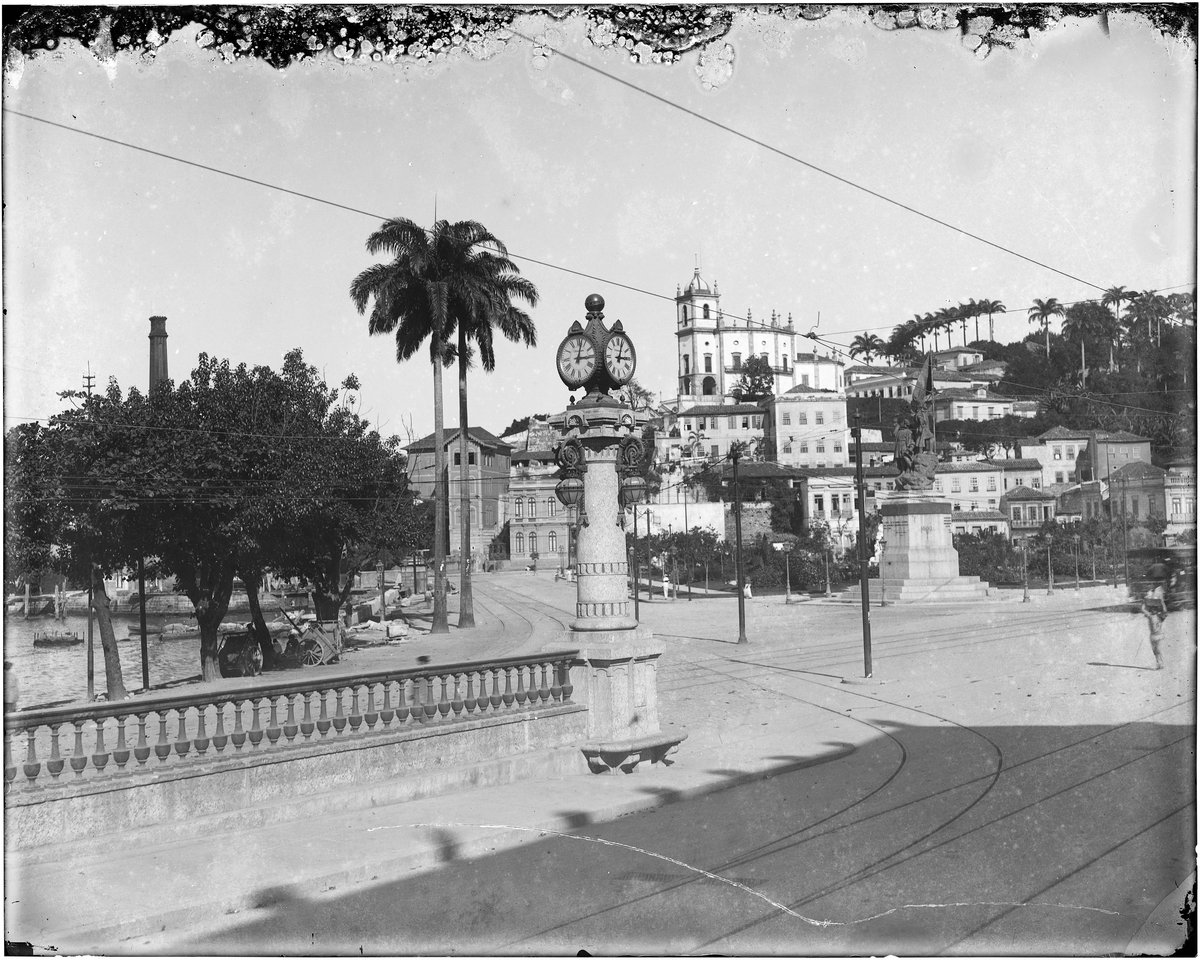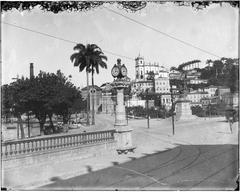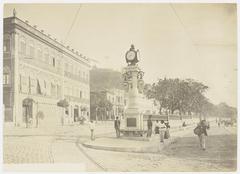
Relógio da Glória Visiting Hours, Tickets, and Complete Guide to Rio de Janeiro Historical Sites
Date: 14/06/2025
Introduction
Nestled in the storied Glória neighborhood of Rio de Janeiro, the Relógio da Glória stands as an enduring testament to the city’s urban transformation and cultural richness. This iconic four-faced clock, perched atop a granite column and bronze balustrade, has marked time for over a century, reflecting Rio’s ambitions, architectural elegance, and neighborhood spirit. Whether you are a history aficionado, architecture lover, or an intrepid traveler, this guide delivers everything you need to know—visiting hours, accessibility, tickets, travel tips, nearby attractions, and cultural context—to make the most of your visit to this remarkable Rio de Janeiro historical site.
(Prefeitura do Rio; Turistando no Rio; Saudades do Rio)
Table of Contents
- Historical Background
- Architectural and Technical Features
- Cultural and Urban Significance
- Restoration and Preservation
- Visiting Information
- Nearby Attractions
- Travel Tips and Accessibility
- Guided Tours and Local Experiences
- Photography and Visuals
- FAQs
- Conclusion
- References
Historical Background
Origins and Construction
The Relógio da Glória was inaugurated on April 15, 1905, during Mayor Pereira Passos’s ambitious modernization of Rio de Janeiro. It was part of a broader urban renewal that included new public lighting, sanitation, and the beautification of the Glória district—then an emblem of the city’s aspirations as a burgeoning capital. The clock’s mechanism, crafted by German watchmaker Frederich Krussman with imported French components, remains operational, making it a rare survivor among the city’s public clocks (Prefeitura do Rio). Its granite column and bronze balustrade were repurposed from Praça Tiradentes, further embedding the monument within Rio’s layered architectural heritage (Diário do Rio).
Urban Context
The clock’s arrival coincided with the transformation of the neighborhood and the creation of Avenida Beira Mar. In an era when direct electrical supply was unavailable, the clock was ingeniously powered by a connection to the local tram system, reflecting the improvisational spirit of early 20th-century Rio (Saudades do Rio).
Architectural and Technical Features
- Four Luminous Faces: The clock features four glass faces with Roman numerals, making it visible from all directions along Rua da Glória.
- Materials: Built atop a robust granite column and encircled by a historic bronze balustrade, the tower integrates elements from Rio’s architectural past.
- Original Mechanism: The clock’s inner workings have been maintained with care, requiring manual adjustments by specialized technicians to this day.
- Inscription: An inscription marks its provenance: “Construído sob a Administração do Prefeito Pereira Passos – 1905” (Urbe Carioca).
- Illumination: The clock is elegantly lit at night, offering a picturesque sight for both locals and visitors.
Cultural and Urban Significance
Relógio da Glória is far more than a timekeeper. It quickly became a neighborhood focal point, a meeting spot, and a symbol of punctuality and civic pride. The clock appears in postcards, paintings, and local literature, reinforcing its status as a cherished landmark (Diário do Rio). It is especially significant during neighborhood events like the Feira da Glória and New Year’s Eve celebrations, when it serves as a communal marker for the passage of time.
Its continued presence speaks to Rio’s dynamic urban identity—bridging past and present, and resonating with both residents and visitors (Turistando no Rio).
Restoration and Preservation
Recognized as a protected heritage site by the Instituto Estadual do Patrimônio Cultural (Inepac) since 1983, the Relógio da Glória has benefited from several restoration projects. The most recent, launched in 2025 ahead of its 120th anniversary, included:
- Mechanical repairs and adjustment of the original mechanism
- Cleaning and conservation of granite and bronze elements
- Enhancements to the lighting and protective casing
These ongoing efforts ensure the monument remains not only functional but visually striking for future generations (Prefeitura do Rio; Diário do Rio).
Visiting Information
Location
- Address: Rua da Glória, 290, Glória, Rio de Janeiro
- Access: Easily reached by metro (Glória station, Linha 1), bus lines, taxis, and ride-sharing services. Simply input “Relógio da Glória” in navigation apps.
Visiting Hours & Tickets
- Hours: The clock is located outdoors and accessible 24/7.
- Tickets: Admission is free; no tickets required.
Accessibility
- Pedestrian-Friendly: The area is generally flat and walkable, though some sidewalks may be uneven due to age.
- Mobility: The nearby metro station is equipped with elevators and ramps, but visitors with limited mobility should exercise caution.
Nearby Attractions
Enhance your visit by exploring these highlights in the Glória neighborhood:
- Igreja de Nossa Senhora da Glória do Outeiro: A breathtaking Baroque church with panoramic views of Guanabara Bay.
- Feira da Glória: The city’s largest open-air market, held on Sundays, offering local foods, crafts, and vibrant street life (Time Out Rio).
- Praça Paris: Beautiful park with gardens and French-inspired design.
- Marina da Glória: Waterfront area for sailing, events, and dining.
- Museu de Arte Moderna (MAM): Modernist museum and landscaped gardens by Burle Marx.
Travel Tips and Accessibility
- Best Time to Visit: Early mornings or late afternoons offer the best lighting for photography. Sundays are lively due to the Feira da Glória.
- Weather: Summers are hot and humid; winters are milder. Carry sunscreen, water, and a rain jacket if visiting in the rainy season (Rough Guides).
- Safety: The area is generally safe during the day. Avoid displaying valuables and use official transportation, especially at night (Worldz Explore).
- Amenities: Cafés and restaurants nearby provide food, drink, and restroom facilities.
Guided Tours and Local Experiences
- Walking Tours: Local guides offer tours that include Relógio da Glória as part of an exploration of Glória’s history and architecture. Fees may apply.
- Self-Guided Resources: Visit @diasdegloria_rj and ogloria.art.br for cultural events and local tips.
- Cultural Venues: Bistrô da Casa and Café Heimen are recommended stops for refreshments and local atmosphere (The Summer Hunter).
Photography and Visuals
- Best Lighting: Golden hours (shortly after sunrise or before sunset) offer ideal conditions for photos.
- Nighttime Views: The illuminated clock is striking after dark, but exercise caution if visiting at night.
- Social Media: Share your photos and experiences online using local hashtags or by tagging neighborhood accounts.
FAQs
Q: What are the visiting hours for Relógio da Glória?
A: The monument is outdoors and accessible 24/7. Daylight hours (8:00 AM – 6:00 PM) are recommended for safety and best viewing.
Q: Is there an admission fee or ticket required?
A: No, visiting is free.
Q: How do I get there by public transport?
A: Take the metro to Glória station or use any major bus line serving the neighborhood.
Q: Are guided tours available?
A: Yes, many walking tours include the monument; check with local operators or online platforms.
Q: Is the site accessible for people with disabilities?
A: The area is mostly accessible, though some sidewalks are uneven.
Q: What nearby attractions should I combine with my visit?
A: Igreja da Glória, Marina da Glória, Praça Paris, and the MAM are all within easy reach.
Conclusion
The Relógio da Glória is more than a historic clock—it is a living symbol of Rio de Janeiro’s journey through urban modernization, cultural renaissance, and neighborhood identity. Free, centrally located, and surrounded by vibrant attractions, it invites visitors to connect with the city’s past and present. Plan your visit during daylight hours, enjoy the lively Glória market, and explore the neighborhood’s many charms for a truly memorable experience.
For the latest updates, guided tour options, and insider tips, follow official local resources or download the Audiala app to enrich your Rio adventure.
References
- Prefeitura do Rio
- Turistando no Rio
- Saudades do Rio
- Diário do Rio
- Guia da Semana
- Time Out Rio
- Rough Guides
- Next Stop Brazil
- The Unknown Enthusiast
- The Summer Hunter
- Worldz Explore
- Diário Carioca
- Rio.com





















































